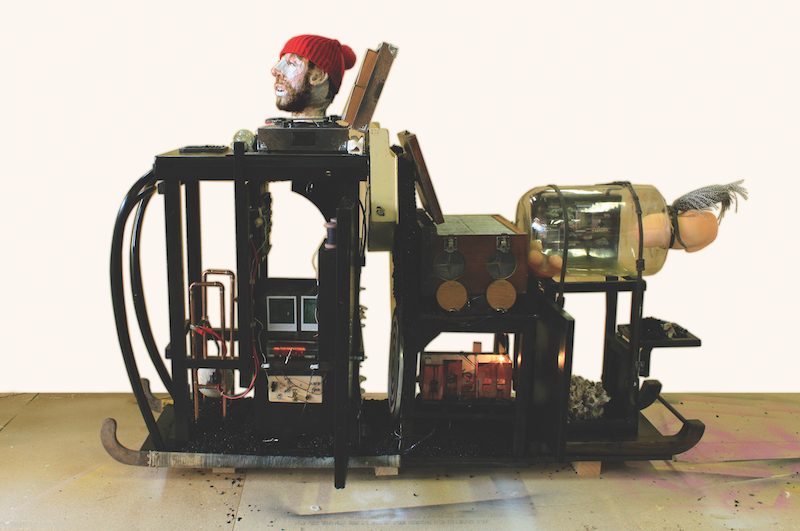Henri Papin: Henri’s Hoards
Henri Papin, an invented character developed by artists Mish Meijers
and Tricky Walsh, unveils his latest collection inspired by fictitious 18th-century prisons.
Words: Briony Downes
IN HENRI PAPIN’S dimly lit workspace, globs of fleshy droplets hang from the ceiling and bulbous pustules appear to ooze from shingle covered walls. Angular wooden structures teeter in shadowy corners and shelves are lined with vials of fluid and time-hardened confectionary. Despite an intermittent clicking sound, it is suspiciously quiet. Deeply sequestered within the Detached Artist Archive – a privately-owned art collection housed in the repurposed interior of Hobart’s Old Mercury Building, – Henri Papin’s Accretion is a multi-room installation two years in the making.
The imagined protagonist of The Collector Project, a speculative fiction developed collaboratively through large scale installations by artists Mish Meijers and Tricky Walsh, Henri Papin has been meticulously building his collection of biologically themed flotsam for more than a decade. “Henri Papin is an avid collector of things,” Meijers and Walsh explain. “In order to fully comprehend a place, person or situation, he accumulates small tokens – like sound, sketches, scent and media – to reconstruct something he has witnessed or experienced.” From framed boxes of loose teeth and yellowed newspaper clippings to jars of urine and volcanic rocks, the objects in Henri’s obsessively hoarded collection serve as wildly varied triggers of memory.
Recently, Henri Papin’s expansive installation The Crocker Land Expedition, 2018 was curated into The National: New Australian Art 2019 by Daniel Mudie Cunningham, director of programs at Sydney’s Carriageworks. The latest chapter of the Henri Papin narrative is The Dark Brain of Piranesi. Occupying the Michael Bugelli Gallery stand at Sydney Contemporary 2019, the new installation is partly inspired by etchings of fictitious prisons created by 18th-century Italian printmaker Giovanni Battista Piranesi and the disused Willow Court Asylum in southern Tasmania. To create the Papin aesthetic, Meijers and Walsh have designed The Dark Brain of Piranesi to resemble a tarnished urban nook. A stained wall is stuck with polaroids of dank interiors and a series of paintings on glass windows illustrate dreamlike smatterings of architecture and anonymous figures.
In the centre of the space sits a campaign sled filled with opening compartments stuffed with spindly mushrooms, shards of crystals and expedition documentation. “Mushrooms and crystals grow in subterranean spaces away from people’s view,” Walsh says. “We often use these objects as loaded metaphors in the Henri collections. The Dark Brain of Piranesi is the next step on from The Crocker Land Expedition.” Underneath the sled is a layer of black, rock-like material resembling volcanic sand from Icelandic beaches, a clue to locations the sled may have traversed.
While Meijers and Walsh each maintain separate art practices, Henri Papin remains an ongoing project allowing the artists to collaborate and build tightly contained worlds and narratives. Together they have researched further into Henri’s potential background during a Rosamond McCulloch Studio Residency in Paris and assembled iterations of The Collector Project in Sydney, Melbourne, Adelaide and Hobart. Currently in its 13th year and continuously unfolding, each subsequent display of The Collector Project adds a new layer to the Henri Papin timeline.
Gallery director Michael Bugelli believes the evolving narrative is a drawcard. “Many people can identify with wanting to invent a character that can make something about themselves more extreme,” he says. “By engaging with Henri, we are reminded even though Henri is truly unusual, society does include some really unusual people.”
Clearly favouring hidden spaces to display his hoard, Henri has been a solitary collector for most of his fictional life. Now his personal haul is becoming increasingly public as he shifts from collector to the collected, how is Henri coping? “Mostly, I think he would be curious to know his stuff is being examined by the public to such a degree,” Walsh says. “Henri collects small, discarded things and he would be intrigued as to why someone else would be interested in something so profoundly personal. Or maybe he would find a kindred spirit.”
Main image: Henri Papin, Campaign sled, 2019. Timber, glass, dentures, plastic eggs, mineral samples, leather strapping, acrylic mirror, motors, optic fibres, crystal radio, polaroids, piano, turntable, paper mache, wool, rubber, paper clay, watercolour, balsa wood, bass wood, silicone, timber, plastic model, coral, video, copper, cables, cardboard, 190 x 60 x 120cm. COURTESY: THE ARTISTS AND MICHAEL BUGELLI GALLERY, HOBART.
This article was originally published in Sydney Contemporary Special Issue Art Collector, 2019.











